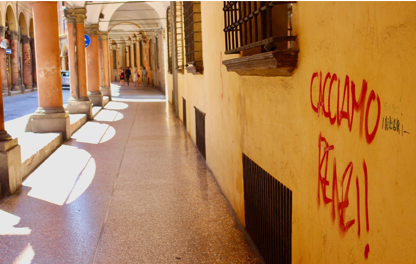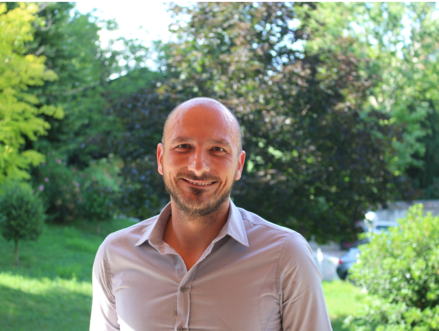On a quiet Saturday in February 2018, 28-year-old Luca Traini stepped out of his car in the central Italian town of Macerata and climbed the steps of a Mussolini-era war memorial. The former political candidate had an Italian flag draped over his shoulders. Upon reaching the top, he made a fascist salute and yelled “Italy for the Italians!” as the police surrounded and arrested him.
Moments before, Traini had fired 30 bullets from his car window, severely injuring six pedestrians — all immigrants from Nigeria, Ghana, Gambia and Mali.
Traini later said that the shooting was his way of avenging the death of an 18-year-old Italian woman who had been killed by a Nigerian man a few weeks before. He heard coverage of the story on the radio and, in his words, “turned around, went home, opened the safe and took the pistol, and decided to kill them all.”
In October 2018, Traini was sentenced to 12 years in prison for the shooting. But his attack on foreigners was only the most severe of a rising number of incidents.
This past June, a group of Italians in Naples used motorcycle helmets to beat a Pakistani kebab shop owner, inside of his shop. Three months earlier, another Pakistani business owner in Rome was set upon by a group of men, who beat him while his car was stopped at a red light. The man fell into a coma.
“There is no place for African people here. Not a good place at least. They’re going to be slaves here because someone is going to take advantage of their position.”– League politician Umberto Bosco
Since Deputy Prime Minister Matteo Salvini, who also serves as interior minister, took office in June, attacks against migrants in Italy have spiked. By the summer of 2018, media reports had counted 12 racially-motivated shootings, two murders and 33 physical assaults against foreign-born residents.

Vigilante groups have also sprung up in northern Italy, some with thousands of members. These groups vary widely in composition and intent, but many are built on anti-immigration sentiments and involve citizens taking “policing” into their own hands, by patrolling their neighborhoods, barring entry into Italian ports and taking to the sea to disrupt Italian Coast Guard’s rescue missions.
During his brief political campaign in Macerata, Traini identified with a far-right political party, The League, which has a stronghold in the north and close ties to many of the most prevalent Italian vigilante groups.
With Salvini at its helm, The League is part of the center-right coalition that won a majority of votes in this year’s election. The party, which shortened its name from the Northern League to widen its appeal, now shares control of the Italian government with the Five Star Movement, an anti-establishment party led by Luigi Di Maio that dominated the polls in Southern Italy.
While The League focuses most of its attention on controlling immigration into Italy, Five Star’s priorities lay in economic reform. Candidates for the Five Star Movement campaigned on the promise of universal basic income — a system where unemployed Italians would receive monthly stipends to help them get back on their feet. This idea resonated strongly in places like Sicily and Naples, where citizens suffered the worst of the country’s economic crisis.
The coalition is led by Prime Minister Giuseppe Conte, who was a little-known law professor before the March 2018 elections.
The Rise of the Right
Italy’s electoral system is particularly complex. For example, Italian voters went to the polls to elect a new parliament in March, but no new government was firmly named until the end of May. This is because President Sergio Mattarella, in a rare move, rejected Salvini and Di Maio’s pick for economy minister, causing early attempts at coalitions between the two parties to fail.
“The president has in the constitution very many powers,” said Gianfranco Pasquino, a former political science professor at the University of Bologna. “If the parties are not cohesive — if the parties do not act in adjoined way, then the president acquires the possibility of playing a significant role. And, he has done so because there were contradictions between the Five Star Movement and The League.”
Mattarella finally approved Conte’s appointment on June 1, only after the group reached a new agreement. This new coalition saw the two leading parties sharing stances on plans to cut taxes, to scrap a previously agreed upon pension plan and to institute a universal basic income policy.
Umberto Bosco, a member of The League’s local government in Bologna, said he believes the success of his party stemmed from Italy’s longstanding immigration crisis.
“We have a big problem with integration, which means turning an immigrant into a citizen,” Bosco said. “You can do it by paper, but doing it by paper is not doing it by reality. An immigrant can only become a citizen when they share the measure and values of a society. If people just obtain citizenship but still keep their values and their ethnic and religious peculiarity, they will never be a citizen.”
Bosco said these clashes with the secular and cultural values of Italy are the reason immigrants from Africa and the Middle East have faced so much discrimination in recent years.
“Our society is based on secular values, and to let them come here is a threat for us, and it’s a threat for them,” he said. “Immigrants are building fascists.”
Italy drew international attention and criticism last June when its new government denied entry to a humanitarian ship carrying more than 600 African refugees and migrants. Of its passengers, who had been plucked from the sea in various rescue missions, 123 were unaccompanied minors.
Following a standoff that lasted more than 24 hours, Spain agreed to accept the migrants into its port — an unprecedented gesture in European affairs.
Politicians from every party mentioned that in the last decade Italy had accepted more African migrants, by way of the migrant sea route, than any other European nation. This is due to its proximity to Libya and to its exposed coasts. Consequently, migration has become a source of significant tension — both between Italy and its allies, and between the government and its population.
Statistics from the Italian government show that migrant arrivals reached a record high in 2016, with more than 181,000 migrants entering Italy. But by the same time last year, that number stood at about 119,000 – the lowest number in five years.

The former Italian government, then led by Matteo Renzi of the center-left Democratic Party, threatened to partly bar rescue ships from Italian ports back in 2017, but never took definitive steps to make good on that threat.
But with the PD reduced to a small minority in the Italian government, Salvini said The League would do everything in its power to close and lock the doors on this type of entry into Italy.
“Malta takes in nobody. France pushes people back at the border. Spain defends its frontier with weapons,” Salvini complained in a Facebook post in June. “From today, Italy will also start to say no to human trafficking, no to the business of illegal immigration.”
While Five Star’s stance on immigration is not as hard line as that of The League, immigration has already proven one of the more difficult aspects of their coalition. Both agree that the immigration policy needs to put Italy first, but Five Star has emphasized the importance of keeping migrants safe, while still encouraging them to find a home elsewhere, according to Silvio Piccini, a member of the Five Star Movement in Italy’s Emilia Romagna region.
“Italy cannot handle this crisis on its own,” Piccini said. “We need help from the rest of Europe, and when we do welcome these people into our country, we need to welcome them with their dignity intact.”
Piccini said “dignity” meant ensuring that immigrants had jobs, and the ability to find a place in Italian society, rather than living as marginalized individuals on the outskirts of towns and cities.
Bosco echoed this sentiment. Unlike Piccini, though, he and The League don’t believe there is a way for African and Middle Eastern immigrants to find “dignity” while living in Italy.
“There is no place for African people here,” Bosco said. “Not a good place at least. They’re going to be slaves here, because someone is going to take advantage of their position.”
PD member Luigi Tosiani said immigration to Italy had actually declined over the past year, even though the public continues to perceive it as rising.
His party advocates for an Italian government that helps migrants, but also delegates some responsibility to other European nations. In his words, the policy should “fall on Italy, but not only Italy.”
Tosiani believes immigrants should be seen as an opportunity for Italy, not a danger, and that it is the government’s responsibility to foster a culture of respect among members of its communities. Although the country’s future is still up in the air, he said one thing is sure: all eyes should be on Italy.
“Nobody can say now whether fascism is the future,” he said. “But Italy is important, and the situation in Italy resembles the situation in the whole world, as we can see from the last elections in the U.S. with Trump, or in France with [President Emmanuel] Macron, or in Hungary with [Prime Minister Viktor] Orbán. We’re actually seeing new forces of populism arising, and this constitutes a crisis for the democracies in Western countries.”

